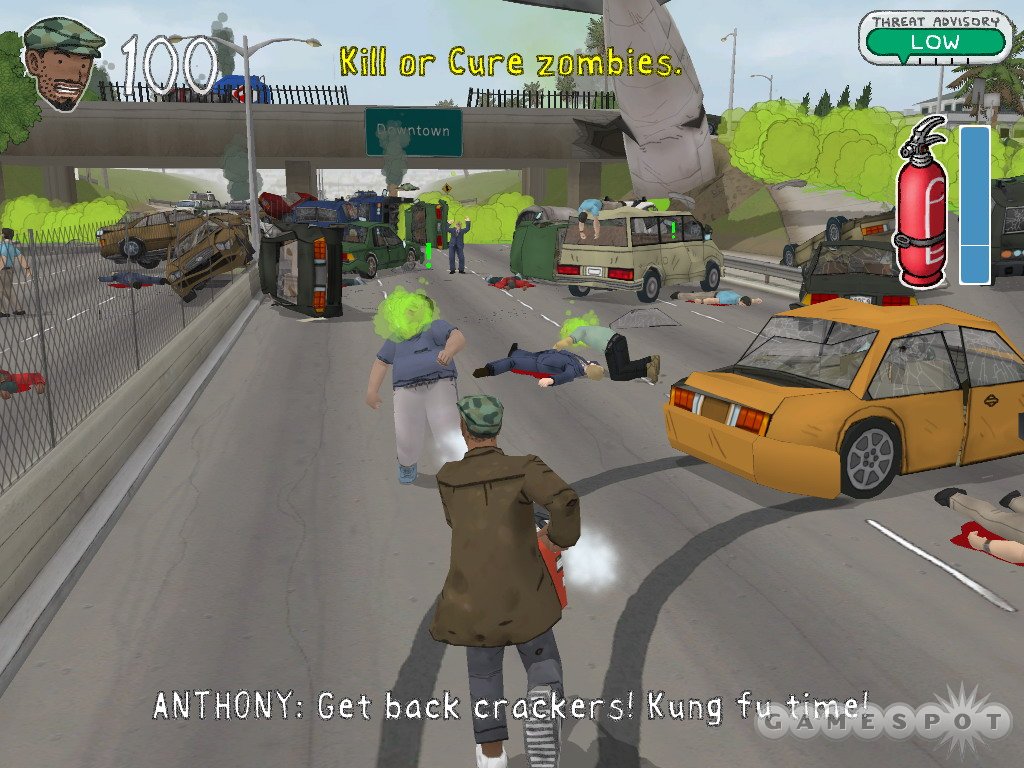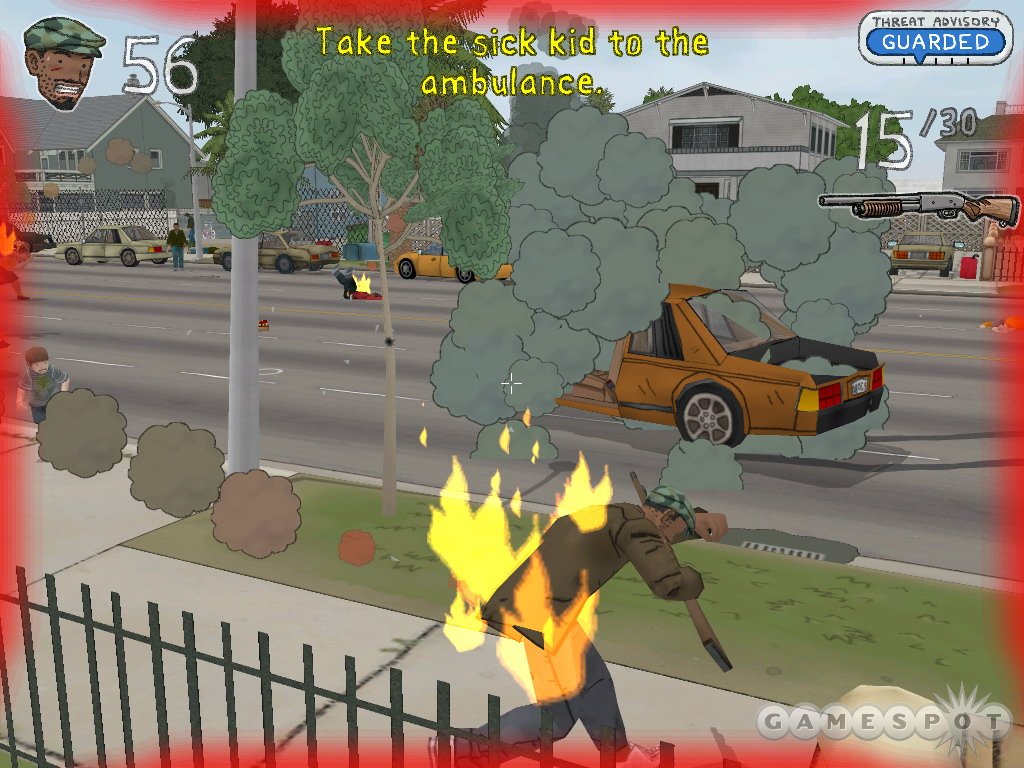Bad Day L.A. Q&A - American McGee's Bad Day
Creative director American McGee discusses in detail his unique and twisted new third-person action adventure game.
Besides having one of the coolest names on the planet, American McGee likes to oversee games that can be described as unique and original. With a resume that includes American McGee's Alice (a twisted take on the classic children's tale) and Scrapland, it's safe to say that McGee doesn't adhere to convention. His latest game, Bad Day L.A., is a perfect example of this. Due out early next year for the Xbox and PC, this third-person action adventure game is about your antihero of a character trying to get through an over-the-top day in Los Angeles, where things just keep going from bad to worse. To keep things from getting bleak, the game is wrapped in a twisted sense of humor that pokes fun at various aspects of American society. To learn more, we caught up with McGee to ask him more about Bad Day L.A.

GameSpot: Tell us about the current state of the game. How far along is it at this point? What parts of the game is the team currently working on?
American McGee: The game is currently in production with development divided between two teams, one in Hong Kong and one in Guangzhou, China. The team in Hong Kong is primarily responsible for management, design, technology, and level design. The team in China is handling art asset production, character animation, and is creating all of our prerendered cinematic content.
The team has been working on the game for a little over a year now. We're nearing the completion of asset production and heading into a phase where we'll be bringing everything together, tuning, and finalizing. That means that the bulk of the development is now shifting entirely to the level designers and programmers in Hong Kong, while the art asset guys move on to other projects.
The team is currently working on things like mission scripting, level polishing, and user interface. At the moment you can play through the first half of the game, although a lot of tuning remains to be done before the experience will be consistently fun. Over the past couple of weeks we've seen a very cool "chaos management" dynamic emerge from the game in an organic way. So in addition to solving the missions and running around defending yourself, you're also working to keep a lid on the constant unrest in the area around you. It's starting to feel something like The Sims with a shotgun.
GS: Tell us about the game's unusual art design. Why did the team decide to use a cartoonlike visual style? Is the line-drawn art intended to be ironic, or some kind of reference to self-help or emergency warning pamphlets?
AM: The art style is meant to be ironic and is making subtle reference to the emergency warning pamphlets that you often see on airplanes. The decision to go with this style was influenced by a number of factors. First, I really wanted a way to offset the graphic nature of the violence that is portrayed in the game so that the focus wasn't gore and death. The game is intended to be humorous, but considering the subject matter that we're dealing with, the art style needs to help blunt the force of the violence a little. Otherwise people aren't going to laugh.
Next, the art style is quintessential "Los Angeles." It does a great job of capturing the city's surreal, gritty, and often ridiculous nature. The art team that established the style is based in Los Angeles, so they have firsthand knowledge of all the little visual details that give the city its soul and character. It seems that the art style has transferred pretty well to the game. Certainly the game is unique in its visual style.
GS: How far along are the game's missions at this point? Can you give us some examples of the kinds of missions and objectives you'll be looking at in the game?
AM: The game script, which describes all the game mission scenarios, was finished some months ago. This document came in at over 120 pages and describes in detail all the various obstacles that the player will encounter throughout the 10 levels that make up this bad day. As I said before, we've completed half the game now, which means about half the missions are available.

The missions and the characters and stories that surround them are often humorously bizarre. They all involve "rescuing" people in one form or another. Of course our hero is just as likely to kill those he's trying to save as he is to actually save them. In our "fire" level, you'll find the player assisting neighborhood parents to round up their drug-crazed children, going into burning houses to save people's loved ones (which often turn out to be blow-up sex dolls), extinguishing burning babies, and helping a bunch of innocent civilians push a bus into a meteor crater so they can escape Molotov cocktail-throwing gang members.
The humor from these missions often comes from our main character's response to being involved with them in the first place. To say he's a reluctant hero would be an understatement. Often times he'll actively resist helping characters that he encounters, only to relent once he realizes that his escape lies in their survival.
Escape from LA, sorta
GS: Can you introduce us to Bad Day L.A.'s supporting cast of characters and explain their roles in the game? Will you actually be able to take control of them and play as them? Will you be able to give them specific orders? 
AM: Our hero is a guy named Anthony Williams. When you meet him he's "homeless by choice" and has given up on society and mankind in general. More than anything he wants to be left alone, but as the bad day goes on he'll find himself increasingly in the role of savior and rescuer. He arms himself with a fire extinguisher, crowbar, and wide range of traditional and nontraditional weapons. His overarching goal for the day is simple: escape.
As for the support characters in the game, there are four of them: The Sick Kid, Juan, Beverly, and The Sergeant. The Sick Kid is the first support character that you encounter. Because of the fact that he's a zombie, he's able to launch a zombie vomit attack. The next character you will encounter is Juan, a Mexican yard worker. He's hit by an ambulance that Anthony is using to escape and has amnesia as a result. His weapons include a chainsaw and a leaf blower, both of which make him handy when fighting zombies. Then comes Beverly, the blonde Beverly Hills bimbo. She's homage to the likes of Britney Spears and Anna Nicole Smith. Her main weapon is a can of industrial-strength mace, but she can also send her yappy little dog to deliver damage to foes. Finally, you'll encounter The Sergeant. He's a cross between George Bush and Arnie, and, in fact, uses Bush quotes whenever being sent into battle or calling for retreat. The idea with these characters is that each offers unique abilities to fight against various enemies. The player has to strategically decide which support character to employ at what times in order to be successful in the game.
The support character game mechanic is really simple. You select which character is primarily active and the others fade into the background. The active character fights by your side until his or her damage gets to be too much, at which time the character's fighting ability is diminished. Cycling to another character gives the worn-out character time to recharge. You cannot deliver specific commands to, or play as, the support characters, but there are times when they will play a role in solving a particular mission by their actions.
GS: While we know the game will take place in LA, we understand that the different levels will actually take place in different neighborhoods and locales. Can you give us some examples of the different environments in the game? How will the gameplay match the environments--will we be fighting crazed movie producers in Hollywood or zombie movie actors rising from beneath the cement stars at Grauman's Chinese Theater?
AM: There are 10 unique locations in the game. They range from the Venice Beach area to downtown Los Angeles and everything in between. Each area features its own local color, like cosplayers outside of the Grauman's Chinese Theater (which, by the way is the "Aztec Theater" in our game, so we don't get sued!). At the time of this interview there are more than 120 unique non-player characters running around in the game. A lot of them are special-use characters that you'll only see in one neighborhood and are there to help sell the idea of that particular area. You'll find yourself fighting everything from MPAA-worshipping theater managers to airport mechanics, mysterious terrorist forces, superfat zombies, jail inmates, and Die Hard-like bank robbers.
GS: Clearly the game is attempting to use humor to poke fun at modern American "fear culture." Is the idea to make people laugh in the hopes that they'll see how ridiculous the team feels this modern paranoia is? How are you approaching the challenge of making the game genuinely funny (and even slightly subversive) without being preachy or overly political?
AM: Certainly I want people to think about the ridiculous nature of fear in US culture these days. I think it is an important conversation, and one that is being thrown in our faces on a daily basis. At times we're a very hypocritical society, demonizing violence or sexual content in video games while at the same time turning a blind eye to real-world warfare and death. Politicians in the US worry themselves about exposing 17-year-old "kids" to video games while gleefully sending 18-year-olds off to war. They promote fear and intolerance while complaining that violent video games are destroying "the children." To any politicians that have beef with video games, I say (quoting their intolerable commander in chief), "Bring 'em on."
Ultimately, these are all very serious topics that we're talking about. I think that a lot of people these days tune out when they hear anything serious, so my hope is that by wrapping these ideas in a subversive "candy coating" of an action comedy game, Bad Day L.A. will manage to get some thoughts rolling and some conversations started where there would otherwise be none.

The game will never be overly preachy or political because the subject is never brought up directly. I'm going to leave that to the politicians and media commentators who seem to have nothing else to do with their time but turn the conversation that direction. When that happens, as has happened every time in the past, it shows how out of touch these people are with the world that we're living in. People who play the game will understand that it is humor and nothing more.
GS: Finally, is there anything else you'd like to add about Bad Day L.A.?
AM: You can find out more on the game by checking out the Bad Day L.A. Web site.
GS: Thanks, American.
Got a news tip or want to contact us directly? Email news@gamespot.com
Join the conversation